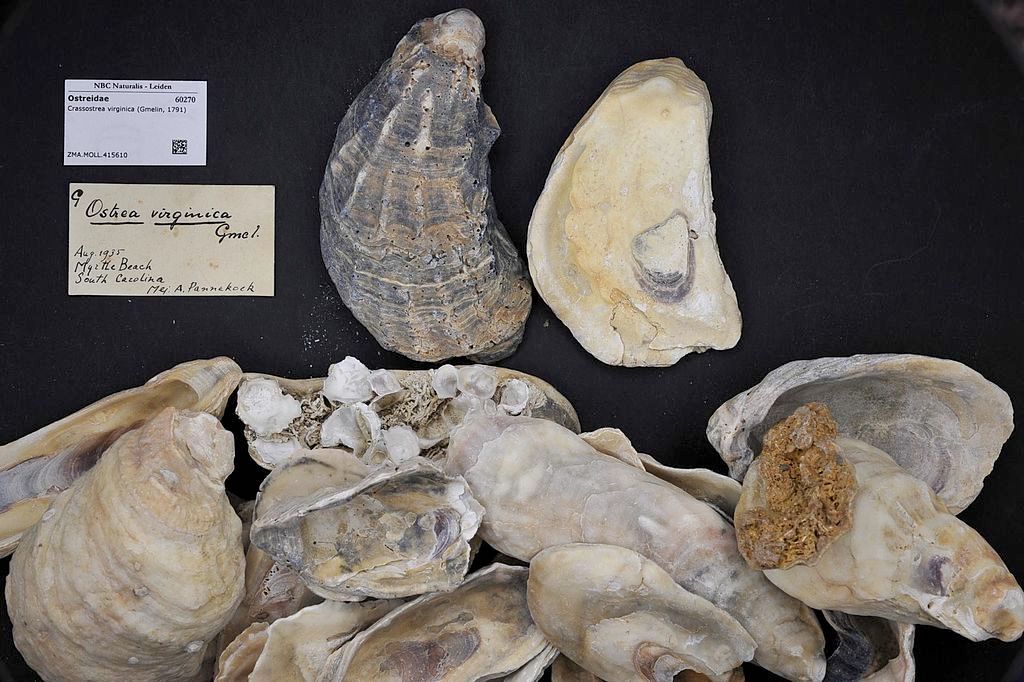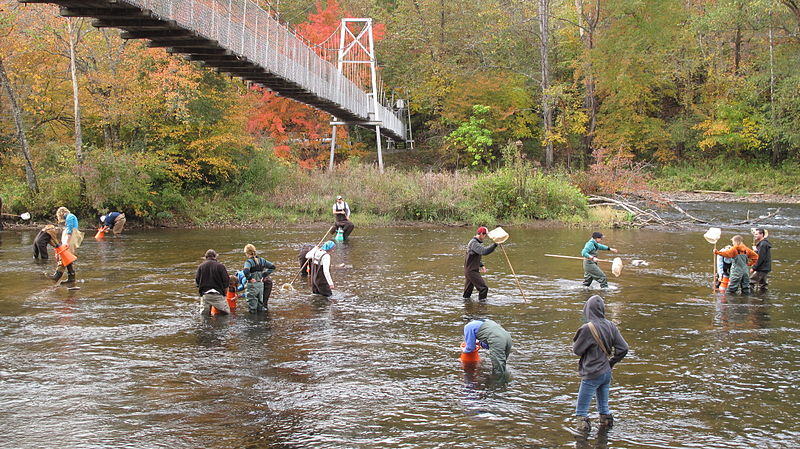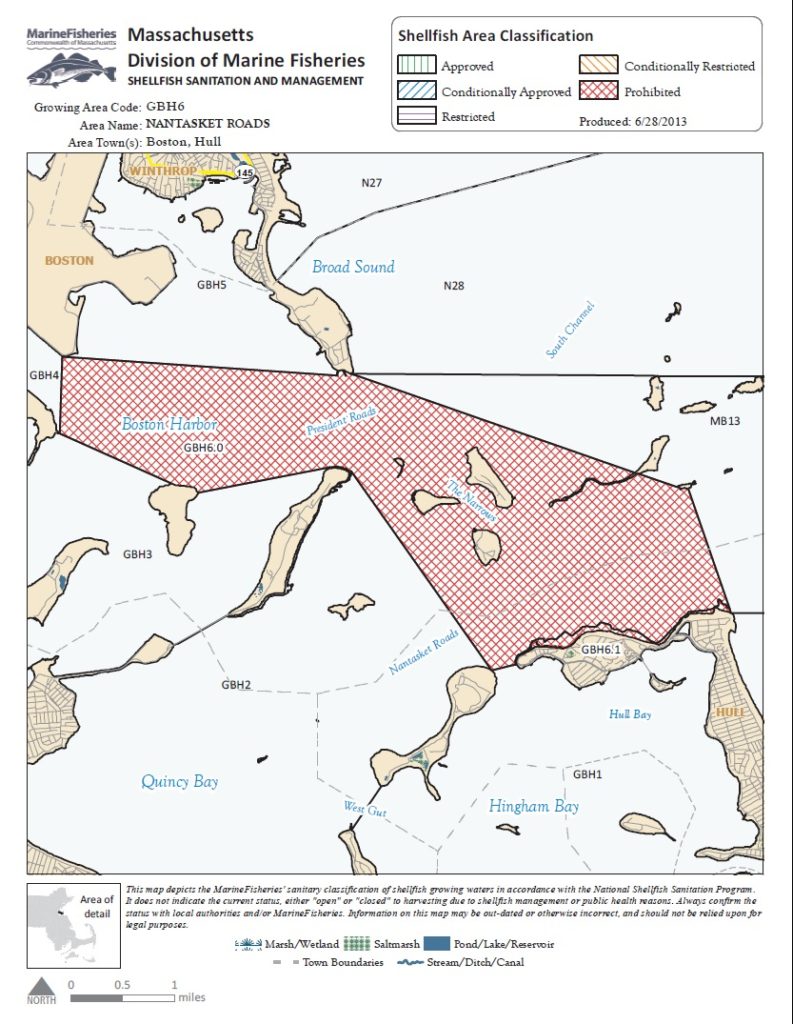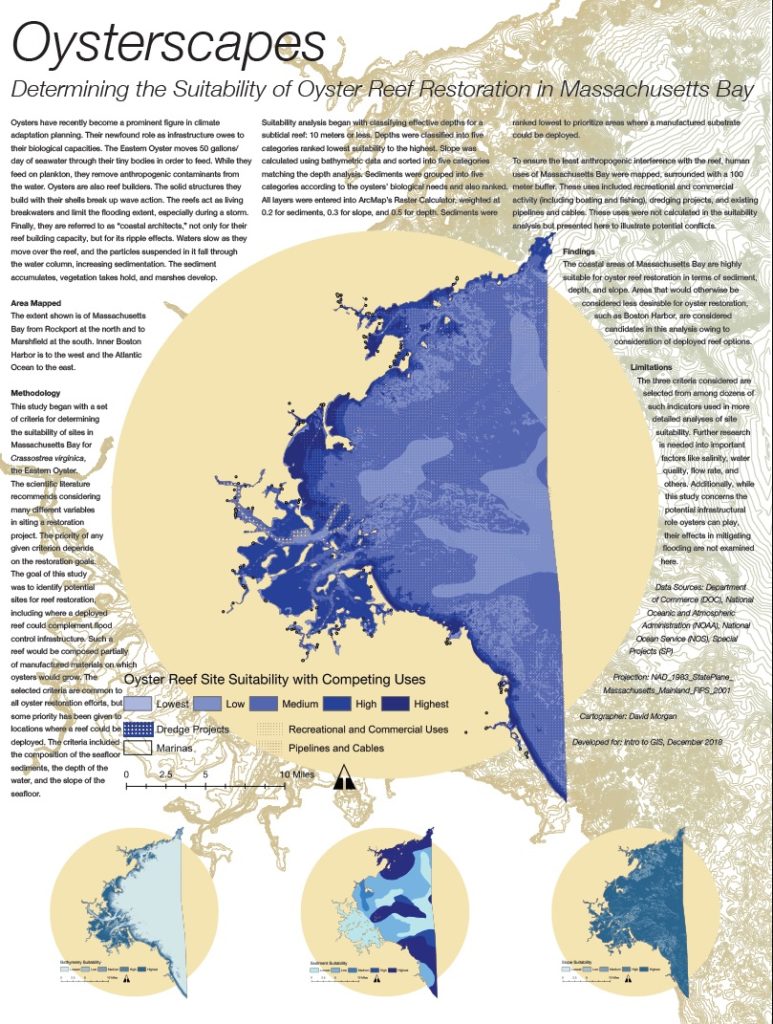UEP graduates David Morgan and Lily Ko were recently honored with the department’s first thesis awards. Below, David provides an overview of his research into multi-species planning for restoring habitats and ultimately, building climate resiliency.
A distinguished urban ecologist and professor once told me that to understand ecology one must learn to see the world from the point of view of a plant. Another told me that grasping hydrology depended on one’s ability to approach the issue like a raindrop. The renowned 20th century conservationist Aldo Leopold urged us to think like a mountain. Aphorisms like these abound in environmental thought, and they become more than mere metaphor in the contexts of nature-based infrastructure and climate adaptation planning.
One local case is exemplary. The Massachusetts Oyster Project (Mass Oyster) conducts oyster restoration as a climate adaptation measure, and ecological restoration efforts like theirs demonstrate the gap between such practices and current environmental policy. Multispecies planning is an effort to bridge that gap, to develop methods for planning that accord with the needs of the landscapes in which climate adaptation and similar projects take place. Informed by recent developments in science, anthropology, and political theory, these methods push boundaries, requiring planners not only to involve a site’s ecology in the development of infrastructures but to reason through problems ecologically.
The convention in environmental conservation is to preserve wilderness from human activity, but in recent years this has been changing. Concepts like multi-use landscapes and cohabitation are indicative and are supported by organizations as large as The Nature Conservancy and United Nations. Such approaches are seen to integrate human land use within ecologies.
“One impetus for this shift is the recognition that no part of Nature is uninfluenced by human activity.”
Climate change is an often-cited example of our global reach, as is carbon-14, the widespread radioactive residue from atom bomb explosions. Nature with a capital N—the pure, untouched territory apart from humans—no longer exists, and has been demonstrated to have always been a hybrid space (Latour 1993; Haraway 2007). An important corollary to this insight is that humans are not Nature’s opposite, but ecological actors with an outsized role.
Ecological restoration has been similarly reframed in light of climate change. Through these practices, whole ecologies are involved in mitigating threats and provisioning benefits. Restored landscapes, in other words, become infrastructures. Some recent developments in environmental policy attempt to capture this philosophical shift, but environmental governance largely retains its Nature bias, treating the nonhuman as passive and inert and static, a backdrop to human activity or the God-given means for human self-realization. Many policies, including those governing shellfish management in Massachusetts, are intentionally disruptive of ecological process. When landscapes are considered infrastructure, such policies become a barrier to climate adaptation.
Mass Oyster is situated amidst these changing practices. During the summer of 2018, the all-volunteer group cared for 60,000 juvenile Eastern oysters and released them into the Annisquam River in Gloucester, MA. Their aim was to seed a wild, self-perpetuating population of oysters. Crassostrea virginica, the Eastern oyster, had long ago vanished from the Annisquam, driven out by human activity. The oysters, however, are essential to the health of the river and marshes—and, considering the effects of climate change, increasingly important to the human settlements along the riverbanks.

Oysters are known in the scientific literature as ecosystem engineers, a turn of phrase that made for their easy entry into planning discussions. Mass Oyster highlights three beneficial effects of oysters-as-infrastructure. The first and most significant is water quality improvement. Being bivalves, oysters feed by filtering water. They metabolize the food they ingest and sequester any waterborne contaminants by expelling them on to the seabed as waste. The second effect is flood protection, which oysters achieve with their reef building habit. Wave action slows as the incoming water moves over an oyster reef and so is unable to reach as far inland. The oysters act as living breakwaters, to use a term popularized by landscape architect Kate Orff (2016). The third effect is habitat restoration. Oyster reefs serve as habitat for hundreds of other species, as a food source, a refuge, a spawning ground, or a home.
Their presence also alters the landscape, making them engineers in the truest sense of the term. Waters slowed by a reef will drop suspended sediments to the sea floor. Over time, these accrete, and new vegetation takes root. The newly formed marsh attracts new species, provides an additional buffer against flooding and storm surge, and further refines water quality—all ripple effects of the oyster far beyond the footprint of the reef.
Materially and pragmatically, Mass Oyster’s climate adaptation infrastructures are jointly produced with nonhuman species, principal among which is Crassostrea virginica. The marine biologists at Mass Oyster described their role as caretakers and facilitators of wildness. The oysters would “do their thing no matter what,” one volunteer said. She saw her role as simply to help coordinate the oysters’ return. Once seeded, she explained, the oysters would “do all the work” of becoming infrastructure. Mass Oyster serves to enhance the wildness of the Annisquam, and a common catchphrase used by volunteers demonstrates what sets the organization apart. Participants often say that Mass Oyster’s work is done “for environmental reasons,” rather than for the commercial ends of aquaculture or the instrumental aims of conventional infrastructure planning. The phrase describes the logic that guides their project, and the source of that logic, which is more than human.
“Wildness is at the heart of Mass Oyster’s approach, and a striking contrast hid in the biologists’ descriptions.”
Where traditional conservation efforts delineate areas for wilderness, these volunteers worked beyond such boundaries to increase the wildness of an urban ecology. They were enhancing a wildness without wilderness. Restoration efforts are also typically given success metrics that often borrow from a wilderness conservation mindset. A pre-colonization (often mistaken for pre-human) population is a typical goal. Mass Oyster, though, expects the oysters to become a sort of ecological infrastructure. They care little for achieving a mythic landscape from the past and instead are focused on attracting a self-sustaining oyster population. They are restoring the future ecology of the Annisquam.
Another marine biologist at Mass Oyster described how the volunteers chose to site their restoration project along the banks of the most travelled river in Massachusetts. Her work required a deep knowledge of Crassostrea virginica’s world. She began with a picture of the oysters’ biological capacities, known in the literature as a species life history, and from there developed a habitat suitability index. She learned the oysters’ preferences for certain types of substrate (rocks and shells) and water quality (low salinity, low flow). She consulted the state shellfish habitat maps and narrowed down site options based on these criteria. More than that, the task required understanding the oysters’ role in the landscape, as formed through their relationships to other animals and plants, to the legacy of sewage pollutants, and to the rising sea levels around them. Eventually, she was able to read the landscape and unpack the knowledge it held about how Crassostrea virginica would fare there.
Mass Oyster’s ecological restoration methods map closely on to anthropologist Anna Tsing’s (2015) methods for studying landscapes. Tsing explores the history, contingency, and relationships of landscape agents, and her work is a celebrated example of the new field of multispecies ethnography. Over the past two decades, multispecies ethnography emerged to study “the effects of our entanglements with other kinds of living selves” (Kohn 2007), and to render nonhuman lives “legibly biographical and political” (Kirksey and Helmreich 2010). Multispecies planning is inspired by and allied with this anthropological project, and the coincidence of Mass Oyster’s and Tsing’s work suggests the value of multispecies methods to planners.
Site histories are central to ecological restoration work. An understanding of what “animals, plants, people, and things” (Ogden, Hall, and Tanita 2013) were once there shapes the possibilities of what a site can become. History reveals a site’s latent tendencies by, for example, detailing intermittent flooding, or explaining its soil quality. In Mass Oyster’s case, a site history revealed what was missing (the Eastern oyster) and the currently existing relationships amongst other landscape agents. Histories also demonstrate what social forces impinge or enhance a restoration project. Gloucester’s longtime lack of a central sewage system, for example, has had toxic repercussions for shellfish in the Annisquam.
The history of a given landscape is closely related to Tsing’s idea of contingency. The conditions given above shaped Mass Oyster’s project, but Tsing also means contingency in the sense of uncertainty, which Mass Oyster encountered in its relationship to state law and other, nonhuman forces. Given the limitations of the state policy environment, Mass Oyster’s work was approved as a pilot for educating about oyster ecology, not as a restoration project. State shellfish guidelines prohibit research projects from establishing permanent populations of the species being studied and other, similar projects have been made to dismantle their efforts after a time. Mass Oyster might have found a workaround by providing public education about the ecological roles Crassostrea virginica can play in the Annisquam. Their work continues today but is still considered provisional. The group also had to contend with potentially losing the seeded oysters to nonhuman forces. During one visit, the volunteers grew concerned that a recent storm had stirred up enough sediment to cover and kill the oysters. Fortunately, their worries were proved unfounded, but the example nevertheless showcased the risks of conducting a properly ecological project: fidelity between plans and outcomes is not guaranteed.
The complexity of ecological relationships contributes to this lack of certainty. Mass Oyster had to account for myriad variables, a process Tsing refers to as understanding the coordinations of the landscape. The biologists weighed the priorities in the habitat suitability index and added others, like the recent arrival of the invasive green crab, which could make short work of eating the juvenile oysters. The restoration site was chosen in part because green crabs were not present there. Local concerns scaled up quickly to global ones. The pace of sea level rise had to be taken into account, as did the warming and more acidic waters resulting from climate change.
While such complexity requires a high level of understanding and analysis, Mass Oyster never assumed they had a full picture of the goings on in the Annisquam, nor did they approach their task as if such a thing were possible. The project relied on other living beings, each with their own wills and drives. The oysters would always “do their thing no matter what.”
“This incalculable variable—the oysters’ wildness—relegated human influence over the project.”
Mass Oyster volunteers were a landscape agent among many, part of an assemblage. Their work joined with the coordinations already present in the Annisquam and fine-tuned them. Tsing’s and Mass Oyster’s methods are, in practical terms, approaches to “living with” other species, rather than simply thinking about or instrumentalizing them (Haraway 2007, emphasis added). Mass Oyster volunteers are attuned to the liveliness of the Eastern oyster and the landscape it inhabits. They encourage wildness, and with it, forms of living with that are not based exclusively on human concerns.
Contrast Mass Oyster’s work with that of the Massachusetts Division of Marine Fisheries (DMF), the agency responsible for permitting shellfish projects in the state. DMF is beholden to federal requirements pertaining to the interstate trade of shellfish, which is a sizeable industry in Massachusetts, and to other state law. The Food and Drug Administration’s National Shellfish Sanitation Program (NSSP) controls the sanitation of harvested shellfish. Any state that violates the agreement can be banned from selling shellfish out of state. Complyingly, DMF’s primary aim is to protect public health. The agency surveys water quality in 303 geographical areas and classifies each according to NSSP guidelines. Aquaculture, research, restoration, or any other similar activity are typically permitted only in areas that meet the water quality criteria for human consumption of shellfish.
DMF must also comply with a state law that complicates NSSP requirements. Massachusetts General Law Chapter 91 requires that all shellfish, no matter their provenance, be made available to harvest. Chapter 91 is a cherished codification of colonial ordinances that gave all residents a right to access the coast, including for shellfishing. Because of the NSSP, DMF disallows seeding of shellfish in contaminated waters, and because of Chapter 91, the agency may resort to interventions where spontaneous self-perpetuating populations form. In short, any shellfish who—facilitated by human activity or not—makes their home in areas designated unsuitable for aquaculture may be relocated to approved waters and later harvested.
DMF’s efforts are laudable attempts to protect human health and navigate a difficult policy environment. Agency documents and employees indicate that they favor restoration and climate adaptation planning but are constrained. Projects like Mass Oyster’s demonstrate DMF’s policy limits. An anthropocentric focus on public health proscribes how humans and nonhumans alike use space. The activities of shellfish—who will propagate anywhere in their habitat range—are inimical to the jurisdictional delineations drawn by DMF. Eastern oysters are excluded from ecologies, prevented from becoming landscape agents, and denied roles as permanent infrastructure by the division’s topology.
This lack is only identifiable from a nonhuman perspective; it takes thinking like an oyster to realize the paucity of anthropocentric marine policy. By contrast, a multispecies planning approach would foster a different topology, a way of evaluating space that is not based exclusively on the topographical map. It would rely instead on what Mass Oyster developed along the Annisquam: a wildness without wilderness. As restorationists know well, ecologies are complex and mobile. They change and adapt according to circumstance; they neither fit neatly within nor obey to the state’s 303 aquaculture area delineations.
Nevertheless, these nonhuman ways of being in the world, moving through it, and forming relations that create and alter the landscape can be recognized in policy. The definitions used in multispecies planning would differ from DMF’s in that shellfish would be defined as landscape agents, rather than a resource. Area delineations would follow from habitat suitability and observed species presence, which is to say the existing or potential relationships amongst agents, rather than jurisdictional or public health criteria. Some newer aspects of environmental policy, like rolling easements, evince the viability of this approach. Compare the Marine Fisheries map of Boston Harbor, produced in accordance with the division’s guidelines, with the Oysterscapes map below, which uses species-specific criteria for the Eastern oyster.
The Oysterscapes map uses a different topology, one that interprets the needs and desires of the Eastern oyster vis a vis the best available science. The criteria for suitable habitat include depth, sediment type, slope, and competing uses (limited, in this case, to human uses.) DMF’s map involves no species criteria, but instead shows where levels of contaminants were evaluated, and a status assigned to indicate whether shellfishing permits would be awarded. The sort of knowledge produced by attending to the topology of the Oysterscapes map offers different political potentials. It draws from the interactions of different landscape agents, human and nonhuman. It includes historical forces like urbanization, represented in the human land use layer, and its purpose is to address future concerns like climate change. Rather than being in the business of limiting interactions and preventing changes, a Division of Marine Fisheries that relied on this form of knowledge would observe and assess ecological flux. This type of knowledge production is like that being generated by contemporary conservation biology studies. It is multivariate, sensitive to contingencies, and, through an implicit assumption that landscape-scale interactions will continue to unfold, admits that its findings are not fixed or stable. Where the Marine Fisheries map is a modern planning document, the Oysterscapes map is a multispecies planning document.
Mass Oyster’s work holds an important lesson, one that is at the heart of multispecies planning. Their process let the landscape lead. Ecological restoration work more generally, especially when framed in terms of climate adaptation, requires accounting for the whole landscape as an active, agentic participant in the making of infrastructure. Drawing from the hard lessons of peak modernism, planners have learned that participatory and democratic methods are at the heart of successful decision making. Multispecies planning suggests that to remain true to this ethos, we must become receptive to more than human concerns and rationales. Indeed, attending to the ways that the nonhuman world responds to us, forces our thoughts and actions, and changes the way we experience the world is climate adaptation work. While climate change is the result of our ignoring or downplaying the significance of our interaction with the nonhuman, climate adaptation should involve our recognition of it through multispecies planning.
Cover image from US Fish and Wildlife Service


